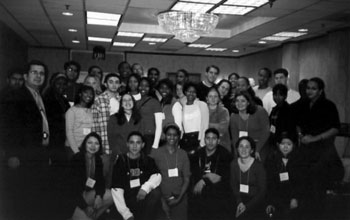
High School Students Bridge
United States-Israel Relationships
by Rob Luchow
United States and Israel relations may appear linked only
by an older generation of politicians. However, one organization
understands that the future stability of this relationship
relies on its youth.
The American Israel Friendship League (AIFL), a non-profit,
non-sectarian organization, provides an opportunity for students
from both countries to meet across the world and discuss political
and social issues. Since its inception in 1977, the US-Israel
High School Youth Ambassadors Student Exchange Program has
brought together over 4,000 students of diverse religions,
ethnic groups and socio-economic statuses from the two nations.
“The overall objective of the program is to teach character
development, tolerance and appreciation for diversity,” said
William Behrer III, Director of Special Projects for the AIFL
and a coordinator for the exchange program. The exchange program
began with the idea of bringing students together, coordinated
by the New York City Board of Education and the Ministry of
Education in Israel. In conjunction with the AIFL, the pilot
program sent 30 New York students to Israel for five weeks.
In its most recent exchange in November, the exchange sent
120 students from cities including Dallas, Tucson, Omaha, and
San Francisco and more than 25 New York students to Israel.
Known as youth ambassadors, the
students spend approximately two weeks in each other’s countries, living and interacting
with a host family thereby gaining greater knowledge and cultural
understanding. The exchange also enables “ambassadors” to
give classroom presentations on US-Israel relationships in
public schools.
“It is important to provide opportunities for young
people to understand what they read,” said Dr. Charlotte
K. Frank, Vice President of the AIFL, chair of the Partners
for Global Education Committee and Senior VP at McGraw-Hill. “There’s
a different reality when students from different countries
meet each other.”
Besides the difference in nationality,
both the AIFL and the exchange program stress the inclusiveness
of the program. Many of the U.S. youth ambassadors are non-Jewish
and come from underrepresented socio-economic backgrounds;
the Israeli youth ambassadors include Druses and Arabs. Ilana
Artman, Executive VP of AIFL said that the program “targets
students who represent the total population of each country.”
With success for over 25 years,
the program looks to expand even further. One addition has
been the “virtual exchange” program
where students from both countries meet in Washington D.C and
New York. They attend workshops on leadership, terrorism, foreign
policy, and conflict which are taught through seminars and
site visits. Outreach is planned to more U.S. and Israeli cities
and to attract an even more diverse population of students.
“This program has given me insight and understanding
towards the people, religions, attitudes and culture of Israel,” said
John Sechrist a 1993 youth ambassador from Norfolk, VA. “I
believe that no textbook, no matter how well written, could
replace the experience I have gained in Israel as a youth ambassador.”#
For
information on AIFL and the exchange program, go to www.aifl.org.
